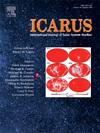探索风驱动的跳跃对火星大气中甲烷的影响
IF 3
2区 物理与天体物理
Q2 ASTRONOMY & ASTROPHYSICS
引用次数: 0
摘要
几十年来,火星大气中甲烷的存在与否一直是一个激烈调查和争论的问题。目前的理论和观察需要一些尚未确定的机制,可以在几周或更短的时间内从火星低层大气中去除甲烷。在这项工作中,我们通过实验测试了火星表面矿物的风驱动跳跃所产生的甲烷封存是否可以解释这些观测结果。在频繁的火星沙尘暴中,沙粒的摩擦电荷可能会提供化学隔离甲烷所需的能量,从而成为火星上甲烷的汇。我们对来自冰岛古弗内斯的玄武岩火星矿物模拟砂进行了实验室实验,这些砂在一个由相同矿物的整体块制成的容器中被端对端翻滚磨损。通过这种方式,在全玄武岩环境中模拟了风驱动的跳跃,并且受到壁面效应的干扰最小。结果表明,在全玄武岩环境中,甲烷在超过100天的模拟跃迁过程中没有受到影响。这与使用石英或玻璃模拟容器的类似实验形成鲜明对比。此外,甲烷在存在过量的与火星有关的氧化剂(如氧气和高氯酸盐)的情况下不受跳跃的影响,这再次与在玻璃容器中进行的实验形成对比。然而,甲烷在活性次氯酸盐的存在下被氧化成二氧化碳。我们的研究结果是在最近关于火星上氧氯化学的报告的背景下进行讨论的,它们强调了在行星环境中风驱动跳跃的实验模拟中考虑壁面效应的必要性。本文章由计算机程序翻译,如有差异,请以英文原文为准。

Exploring the impact of wind-driven saltation on methane in the atmosphere of Mars
The presence or absence of methane in the atmosphere of Mars has been a matter of intense investigations and debate for decades. Current theories and observations require some as-yet unidentified mechanism that can remove methane from the lower martian atmosphere on a timescale of a few weeks or less.
In this work, we experimentally tested if methane sequestration by wind-driven saltation of martian surface minerals can explain the observations. Triboelectric charging of sand particles during the frequent martian dust storms could potentially provide the energy needed to chemically sequester methane and thereby act as a sink for methane on Mars. We performed laboratory experiments with basaltic martian mineral analog sand from Gufunes, Iceland, which was abraded by tumbling end-over-end in a container made from a monolithic block of the same mineral. In this way, wind-driven saltation was simulated in an all-basalt environment with minimal interference from wall-effects.
The results show that methane is not affected during more than 100 terrestrial days of simulated saltation in the all-basalt environment. This stands in contrast to similar experiments using quartz or glass simulation containers. Furthermore, methane remains unaffected by saltation in the presence of excess amounts of Mars-relevant oxidants, such as oxygen and perchlorate salt, which again contrasts to experiments performed in glass containers. However, methane is oxidized to carbon dioxide in the presence of reactive hypochlorite salt. Our results are discussed in the context of recent reports on the chemistry of oxychlorine species on Mars, and they highlight the need to account for wall-effects in experimental simulations of wind-driven saltation in planetary environments.
求助全文
通过发布文献求助,成功后即可免费获取论文全文。
去求助
来源期刊

Icarus
地学天文-天文与天体物理
CiteScore
6.30
自引率
18.80%
发文量
356
审稿时长
2-4 weeks
期刊介绍:
Icarus is devoted to the publication of original contributions in the field of Solar System studies. Manuscripts reporting the results of new research - observational, experimental, or theoretical - concerning the astronomy, geology, meteorology, physics, chemistry, biology, and other scientific aspects of our Solar System or extrasolar systems are welcome. The journal generally does not publish papers devoted exclusively to the Sun, the Earth, celestial mechanics, meteoritics, or astrophysics. Icarus does not publish papers that provide "improved" versions of Bode''s law, or other numerical relations, without a sound physical basis. Icarus does not publish meeting announcements or general notices. Reviews, historical papers, and manuscripts describing spacecraft instrumentation may be considered, but only with prior approval of the editor. An entire issue of the journal is occasionally devoted to a single subject, usually arising from a conference on the same topic. The language of publication is English. American or British usage is accepted, but not a mixture of these.
 求助内容:
求助内容: 应助结果提醒方式:
应助结果提醒方式:


